过去进行时教案分析
过去进行时教学设计方案

一、教学目标1. 知识目标:(1)学生能够理解过去进行时的概念和用法。
(2)学生能够正确运用过去进行时描述过去某个时间段正在进行的动作或状态。
2. 能力目标:(1)学生能够通过语境理解和运用过去进行时。
(2)学生能够在实际交流中正确运用过去进行时。
3. 情感目标:(1)激发学生学习英语的兴趣,提高学生的英语学习积极性。
(2)培养学生对英语文化的理解和尊重。
二、教学重难点1. 教学重点:过去进行时的构成、用法和句型结构。
2. 教学难点:过去进行时与一般过去时的区别,以及在不同语境中的运用。
三、教学过程1. 导入- 利用图片、视频或故事导入,引导学生回顾过去某个时间段正在进行的动作或状态。
2. 新课呈现- 通过PPT展示过去进行时的构成(was/were + 动词的ing形式),并结合例句进行讲解。
- 引导学生分析过去进行时的用法,如描述过去某个时间段正在进行的动作或状态。
3. 练习环节- 基础练习:给出一般现在时的句子,让学生将其改为过去进行时。
- 中级练习:给出情境,让学生用过去进行时描述过去某个时间段正在进行的动作或状态。
- 高级练习:给出一段对话或短文,让学生找出其中的过去进行时句子,并分析其用法。
4. 课堂活动- 分组讨论:让学生分组讨论过去进行时的用法,并分享自己的观点。
- 角色扮演:让学生分组进行角色扮演,用过去进行时进行对话。
5. 总结与反思- 教师总结本节课所学内容,强调过去进行时的构成、用法和句型结构。
- 学生反思自己在学习过程中遇到的困难和收获,并提出改进建议。
6. 作业布置- 完成课后练习,巩固所学知识。
- 选择一个过去发生的事件,用过去进行时写一篇短文。
四、教学评价1. 课堂表现:观察学生在课堂上的参与度、发言积极性和正确运用过去进行时的能力。
2. 作业完成情况:检查学生课后练习和短文写作的质量,评估学生对过去进行时的掌握程度。
3. 课后访谈:与学生进行个别访谈,了解他们对过去进行时的理解和运用情况。
过去进行时的课程设计
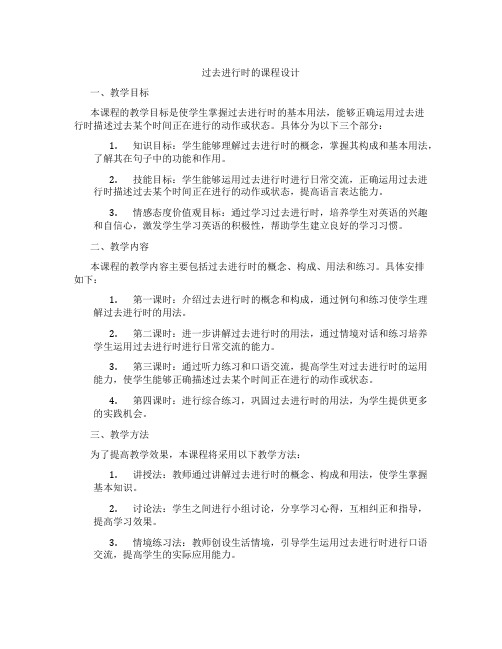
过去进行时的课程设计一、教学目标本课程的教学目标是使学生掌握过去进行时的基本用法,能够正确运用过去进行时描述过去某个时间正在进行的动作或状态。
具体分为以下三个部分:1.知识目标:学生能够理解过去进行时的概念,掌握其构成和基本用法,了解其在句子中的功能和作用。
2.技能目标:学生能够运用过去进行时进行日常交流,正确运用过去进行时描述过去某个时间正在进行的动作或状态,提高语言表达能力。
3.情感态度价值观目标:通过学习过去进行时,培养学生对英语的兴趣和自信心,激发学生学习英语的积极性,帮助学生建立良好的学习习惯。
二、教学内容本课程的教学内容主要包括过去进行时的概念、构成、用法和练习。
具体安排如下:1.第一课时:介绍过去进行时的概念和构成,通过例句和练习使学生理解过去进行时的用法。
2.第二课时:进一步讲解过去进行时的用法,通过情境对话和练习培养学生运用过去进行时进行日常交流的能力。
3.第三课时:通过听力练习和口语交流,提高学生对过去进行时的运用能力,使学生能够正确描述过去某个时间正在进行的动作或状态。
4.第四课时:进行综合练习,巩固过去进行时的用法,为学生提供更多的实践机会。
三、教学方法为了提高教学效果,本课程将采用以下教学方法:1.讲授法:教师通过讲解过去进行时的概念、构成和用法,使学生掌握基本知识。
2.讨论法:学生之间进行小组讨论,分享学习心得,互相纠正和指导,提高学习效果。
3.情境练习法:教师创设生活情境,引导学生运用过去进行时进行口语交流,提高学生的实际应用能力。
4.视听法:利用多媒体教学资源,播放相关视频和音频,丰富教学手段,提高学生的学习兴趣。
四、教学资源为了支持教学内容和教学方法的实施,本课程将采用以下教学资源:1.教材:《英语课程标准》及相关配套练习册。
2.参考书:英语语法大全、英语口语教程等。
3.多媒体教学资源:PPT、教学视频、音频等。
4.实验设备:语音设备、投影仪等。
通过以上教学资源的支持,为学生提供丰富的学习体验,提高教学效果。
小学教案初步认识过去进行时
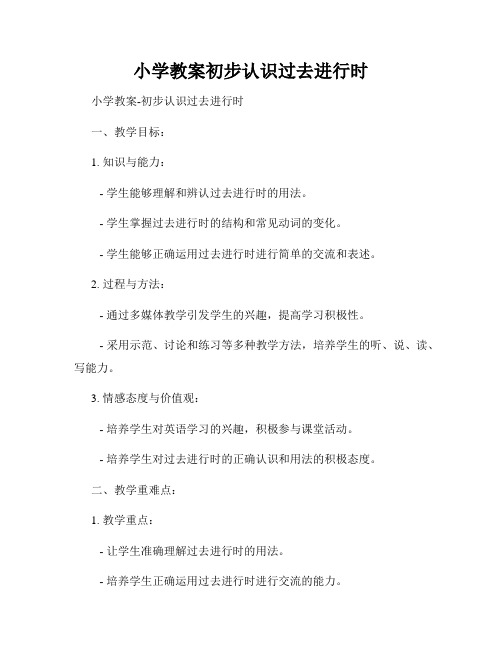
小学教案初步认识过去进行时小学教案-初步认识过去进行时一、教学目标:1. 知识与能力:- 学生能够理解和辨认过去进行时的用法。
- 学生掌握过去进行时的结构和常见动词的变化。
- 学生能够正确运用过去进行时进行简单的交流和表述。
2. 过程与方法:- 通过多媒体教学引发学生的兴趣,提高学习积极性。
- 采用示范、讨论和练习等多种教学方法,培养学生的听、说、读、写能力。
3. 情感态度与价值观:- 培养学生对英语学习的兴趣,积极参与课堂活动。
- 培养学生对过去进行时的正确认识和用法的积极态度。
二、教学重难点:1. 教学重点:- 让学生准确理解过去进行时的用法。
- 培养学生正确运用过去进行时进行交流的能力。
2. 教学难点:- 让学生理解过去进行时和其他时态的区别。
- 培养学生正确运用过去进行时的能力。
三、教学准备:1. 教材准备:- 多媒体课件、教学录音机、黑板、笔等。
2. 学生准备:- 学生需提前预习过去进行时的相关知识。
四、教学过程:1. 导入(约5分钟):- 利用多媒体课件播放一段有关过去进行时的视频片段,引发学生的兴趣。
2. 语言输入(约10分钟):- 教师通过展示示例句子和图片,引导学生观察并猜测过去进行时的用法。
3. 概念解释(约15分钟):- 教师具体解释过去进行时的用法和注意事项,讲解过去进行时结构的组成和常见动词的变化。
4. 语言输出(约20分钟):- 学生分组,自编对话,使用过去进行时进行简单的情景表演。
5. 操练练习(约20分钟):- 教师通过多种操练形式,如填空、改错、连线等,巩固学生对过去进行时的理解和运用。
6. 合作交流(约10分钟):- 学生再次分组,以小组为单位,彼此展示自己编写的对话并相互评价,加深对过去进行时的理解。
7. 总结和拓展(约10分钟):- 教师对本节课的要点进行总结,并提供一些拓展练习,让学生进行自主学习。
五、教学反思:本节课采用了多媒体教学和分组练习的方式,使学生能够参与课堂互动并加深对过去进行时的理解。
过去进行时教案

过去进行时教案
过去进行时教学设计
西林中学:李秀珍
一、教材分析:
1.位置和内容: 外研版八年级下册第七模块第三课时。
谈论如何使用过去进行时。
如何使
用过去进行时是本单元的重点内容。
同时我创造了一些便于进行沟通交流的情境,让学生学会使用过去进行时。
过去进行时是以前学生从未接触过的一个语法项目。
这是一节前置语法课。
学生对现在进行时已经比较熟悉,过去进行时的结构和用法与之较为相似。
2.教学重点:如何使用过去进行时。
3.教学难点:如何在由when, while引导的时间状语使用过去进行时。
二、教学目标:
1.知识目标:要求学生掌握使用过去进行时。
2.能力目标:让学生做课堂的主人,培养他们掌握一些行之有效的学习方法,优化学习效果。
3.情感目标:让学生爱上英语课堂活动,鼓励他们在课堂上进行合作交流。
4.学习策略目标:设法使学生掌握使用英语进行交流,学习积极参与班级活动. 通过师友
合作的学习模式来巩固所学时态。
三、教学方法:
1)和谐互助高效课堂教学模式:
2)小组合作
1。
初中英语过去进行时教案

初中英语过去进行时优秀教案一、教学目标:1. 让学生掌握过去进行时的概念和用法。
2. 培养学生用过去进行时进行交际的能力。
3. 提高学生对英语时态的认知和运用能力。
二、教学内容:1. 过去进行时的定义:过去进行时表示过去某个时间正在进行的动作或状态。
2. 过去进行时的结构:主语+ was/were + 动词ing。
3. 过去进行时的用法:描述过去某个时间正在进行的动作或状态。
三、教学重点和难点:1. 过去进行时的结构。
2. 过去进行时的用法。
四、教学方法:1. 任务型教学法:通过完成各种任务,让学生在实践中学习和运用过去进行时。
2. 情境教学法:创设各种情境,让学生在真实的环境中感受和理解过去进行时。
3. 交际教学法:通过小组讨论、角色扮演等活动,培养学生用过去进行时进行交际的能力。
五、教学过程:1. 导入:引导学生回顾一般现在时和一般过去时的用法,为新课的学习做好铺垫。
2. 讲解:讲解过去进行时的定义、结构和用法,并通过例句进行说明。
3. 实践:让学生完成一些练习题,巩固对过去进行时的掌握。
4. 交际:组织学生进行小组讨论和角色扮演,让学生在实际语境中运用过去进行时。
5. 总结:对本节课的内容进行总结,强调过去进行时的关键点。
6. 作业:布置一些课后练习,让学生进一步巩固过去进行时的用法。
六、教学评价:1. 通过课堂观察,评估学生对过去进行时的掌握程度。
2. 通过课后练习的完成情况,了解学生对过去进行时的运用能力。
3. 组织一次小测验,测试学生对过去进行时的理解和运用。
七、教学拓展:1. 引导学生运用过去进行时描述自己的日常活动,提高学生的实际运用能力。
2. 让学生尝试创作小故事,运用过去进行时展开情节,培养学生的创造性思维。
八、教学资源:1. PPT课件:展示过去进行时的定义、结构、用法及例句。
2. 练习题:提供不同难度的练习题,巩固学生对过去进行时的掌握。
3. 角色扮演卡片:用于组织学生进行角色扮演活动。
英语过去进行时公开课教案
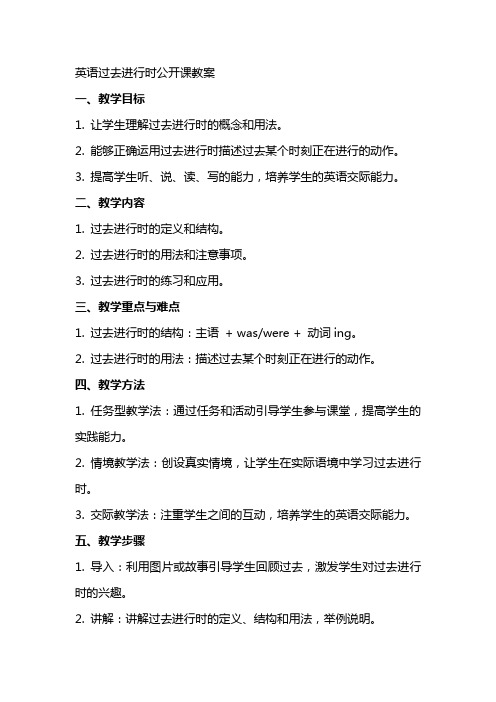
英语过去进行时公开课教案一、教学目标1. 让学生理解过去进行时的概念和用法。
2. 能够正确运用过去进行时描述过去某个时刻正在进行的动作。
3. 提高学生听、说、读、写的能力,培养学生的英语交际能力。
二、教学内容1. 过去进行时的定义和结构。
2. 过去进行时的用法和注意事项。
3. 过去进行时的练习和应用。
三、教学重点与难点1. 过去进行时的结构:主语+ was/were + 动词ing。
2. 过去进行时的用法:描述过去某个时刻正在进行的动作。
四、教学方法1. 任务型教学法:通过任务和活动引导学生参与课堂,提高学生的实践能力。
2. 情境教学法:创设真实情境,让学生在实际语境中学习过去进行时。
3. 交际教学法:注重学生之间的互动,培养学生的英语交际能力。
五、教学步骤1. 导入:利用图片或故事引导学生回顾过去,激发学生对过去进行时的兴趣。
2. 讲解:讲解过去进行时的定义、结构和用法,举例说明。
3. 练习:分小组进行角色扮演,运用过去进行时描述过去某个时刻正在进行的动作。
4. 活动:设计听力、口语、阅读和写作练习,巩固过去进行时的运用。
5. 总结:对本节课的内容进行总结,强调过去进行时的关键点。
6. 作业:布置相关练习题,让学生课后巩固所学知识。
六、教学评估1. 课堂观察:观察学生在课堂活动中的参与程度、发音准确性以及过去进行时的运用情况。
2. 小组讨论:评估学生在小组讨论中的互动交流,关注他们是否能正确使用过去进行时描述情境。
3. 练习答案:检查学生作业和练习册上的答案,评估他们对过去进行时的理解和掌握程度。
七、教学拓展1. 引导学生思考过去进行时在实际生活中的应用,例如:回忆难忘的经历、描述过去的重要事件等。
2. 介绍过去进行时的相关语法规则,如:过去进行时与过去完成时的区别。
3. 推荐相关英语学习资源,如:图书、电影、在线课程等,帮助学生进一步巩固过去进行时的知识。
八、教学反馈1. 课堂反馈:鼓励学生在课堂上积极提问,及时解答他们的疑问,确保他们对过去进行时的理解。
初中英语课教案过去进行时含反思2
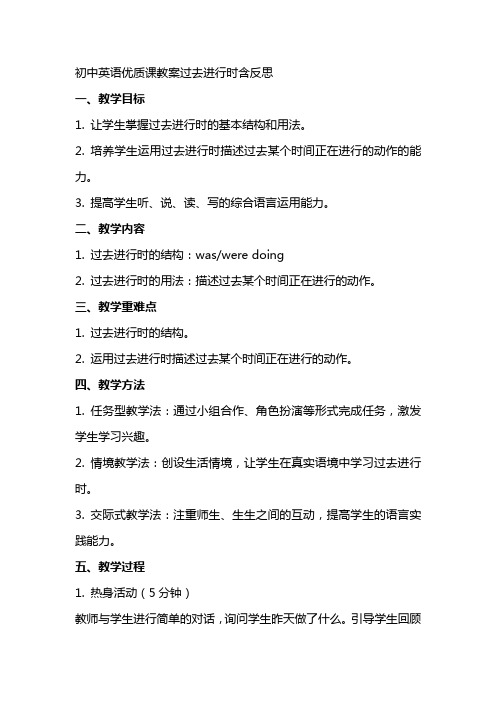
初中英语优质课教案过去进行时含反思一、教学目标1. 让学生掌握过去进行时的基本结构和用法。
2. 培养学生运用过去进行时描述过去某个时间正在进行的动作的能力。
3. 提高学生听、说、读、写的综合语言运用能力。
二、教学内容1. 过去进行时的结构:was/were doing2. 过去进行时的用法:描述过去某个时间正在进行的动作。
三、教学重难点1. 过去进行时的结构。
2. 运用过去进行时描述过去某个时间正在进行的动作。
四、教学方法1. 任务型教学法:通过小组合作、角色扮演等形式完成任务,激发学生学习兴趣。
2. 情境教学法:创设生活情境,让学生在真实语境中学习过去进行时。
3. 交际式教学法:注重师生、生生之间的互动,提高学生的语言实践能力。
五、教学过程1. 热身活动(5分钟)教师与学生进行简单的对话,询问学生昨天做了什么。
引导学生回顾过去,为新课的学习做好铺垫。
2. 导入新课(10分钟)教师展示一组图片,展示不同人在做不同的事情,引导学生用过去进行时描述图片内容。
例如:“Yesterday, I was watching TV.”3. 讲解过去进行时(15分钟)教师通过示例和讲解,让学生掌握过去进行时的结构(was/were doing)和用法(描述过去某个时间正在进行的动作)。
4. 小组活动(15分钟)学生分组,每组成员用过去进行时描述昨天发生的有趣事情。
每组选取一名代表进行汇报。
5. 课堂练习(10分钟)教师设计练习题,让学生运用过去进行时进行句子编写。
学生完成后,教师进行点评和指导。
6. 总结与反思(5分钟)教师引导学生总结本节课所学内容,让学生谈一谈自己在课堂上的收获和不足,为今后的学习制定目标。
7. 课后作业(课后自主完成)学生根据课堂所学,运用过去进行时编写一段对话,描述昨天在学校的活动。
教学反思:本节课通过图片、示例、练习等多种教学手段,让学生掌握了过去进行时的结构和用法。
在教学过程中,注重了师生、生生之间的互动,提高了学生的语言实践能力。
过去进行时教案

过去进行时教案第一篇:过去进行时教案Teaching Plan 1.T eaching content(教学内容): The Past Continuous Tense(过去进行时态)2.Analysis of teaching material(教材分析): 由于我是教的语法,按照教学大纲,结合语法体系,我这节课将要讲到的是过去进行时态。
因为之前学生已经学习了一般现在时、现在进行时、一般过去时,所以这个时态对于学生来说并不是很难的。
让学生在一个轻松快乐的环境中很好的掌握好此时态是我的目标。
所以我针对教学内容,设计了一系列的活动,让整个教学内容很好的贯穿于一个个活动中。
3.Teaching objectives(教学目标):a.Knowledge ojectives(知识目标)要求学生掌握使用过去进行时b.Ability objectives(能力目标)让学生做课堂的主人,培养他们掌握一些行之有效的学习方法,优化学习效果c.Emotional objectives(情感目标)1.让学生爱上英语课堂活动,鼓励他们在课堂上进行合作交流2.设法使学生掌握使用英语进行交流,学习积极参与班级活动。
通过大量练习来巩固所学时态4.Teaching key points(教学重点)1.复习过去进行时的用法;2.学习新的词汇和短语的用法5.Teaching difficult points(教学难点)1.让学生了解在怎样的情景下使用过去进行时;2.创设情景设计话题,使语法项目在交际活动和完成任务中得到熟练掌握6.Teaching methods(教学方法)1.任务型教学法:2.情景教学法3.交际教学法7.Teaching aids(教学用具)a computer, CAI, a recorder, the blakboard 8.Teachingprocedures(教学过程)StepⅠ导入 1.呈现图片1)T:What are you doing when I enter the classroom?2)T::Please look at the pictures on the screen and then tell me what they are doing?【设计说明】这些图片的设计目的在于吸引学生的注意力,让他们能立刻进入角色,投入到学习中来。
过去进行时教案分析doc资料
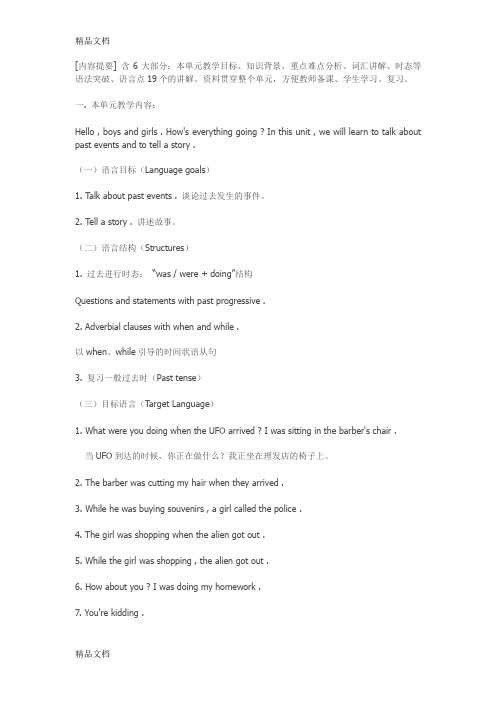
[内容提要] 含6大部分:本单元教学目标、知识背景、重点难点分析、词汇讲解、时态等语法突破、语言点19个的讲解。
资料贯穿整个单元,方便教师备课、学生学习、复习。
一. 本单元教学内容:Hello , boys and girls . How's everything going ? In this unit , we will learn to talk about past events and to tell a story .(一)语言目标(Language goals)1. Talk about past events . 谈论过去发生的事件。
2. Tell a story . 讲述故事。
(二)语言结构(Structures)1. 过去进行时态:“was / were + doing”结构Questions and statements with past progressive .2. Adverbial clauses with when and while .以when、while引导的时间状语从句3. 复习一般过去时(Past tense)(三)目标语言(Target Language)1. What were you doing when the UFO arrived ? I was sitting in the barber's chair .当UFO到达的时候,你正在做什么?我正坐在理发店的椅子上。
2. The barber was cutting my hair when they arrived .3. While he was buying souvenirs , a girl called the police .4. The girl was shopping when the alien got out .5. While the girl was shopping , the alien got out .6. How about you ? I was doing my homework .7. You're kidding .(四)词汇(Vocabulary)1. 部分动词的过去式took off(起飞、脱下) arrived(到达) landed(着陆)got out(下车、下来) shouted(喊叫) climbed(爬)happened(发生) ran away(逃跑)2. 部分动词的-ing形式cutting cooking eating getting out goingmaking shouting sleeping standing studyingtaking talking climbing buying coming3. when、while 当……时候4. bathroom(浴室) barber's(理发店) barber shop 理发店 shower(淋浴) police officer(警官)5. another(另一个) jump down(跳下来) go up(向上去)in front of(在……前面)(五)重点、难点分析1. 过去进行时:表示在过去某一时间内正在进行的动作。
试讲教案过去进行时
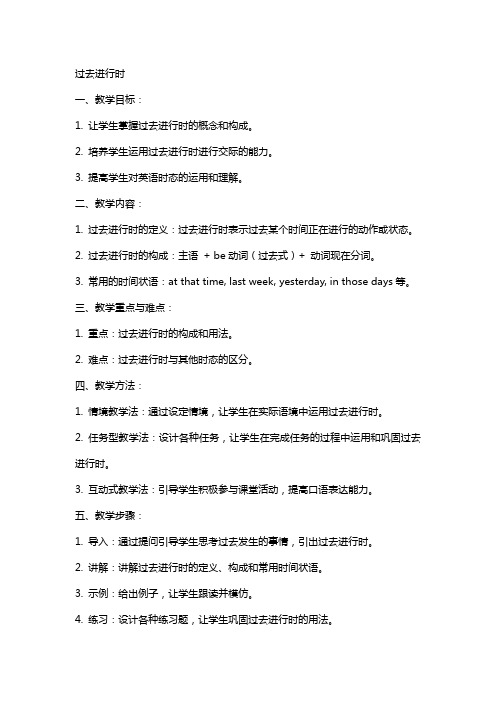
过去进行时一、教学目标:1. 让学生掌握过去进行时的概念和构成。
2. 培养学生运用过去进行时进行交际的能力。
3. 提高学生对英语时态的运用和理解。
二、教学内容:1. 过去进行时的定义:过去进行时表示过去某个时间正在进行的动作或状态。
2. 过去进行时的构成:主语+ be动词(过去式)+ 动词现在分词。
3. 常用的时间状语:at that time, last week, yesterday, in those days等。
三、教学重点与难点:1. 重点:过去进行时的构成和用法。
2. 难点:过去进行时与其他时态的区分。
四、教学方法:1. 情境教学法:通过设定情境,让学生在实际语境中运用过去进行时。
2. 任务型教学法:设计各种任务,让学生在完成任务的过程中运用和巩固过去进行时。
3. 互动式教学法:引导学生积极参与课堂活动,提高口语表达能力。
五、教学步骤:1. 导入:通过提问引导学生思考过去发生的事情,引出过去进行时。
2. 讲解:讲解过去进行时的定义、构成和常用时间状语。
3. 示例:给出例子,让学生跟读并模仿。
4. 练习:设计各种练习题,让学生巩固过去进行时的用法。
5. 任务:分组进行角色扮演,运用过去进行时进行交际。
7. 作业:布置作业,要求学生运用过去进行时进行写作。
8. 反馈:课后收集学生的作业,对学生的掌握情况进行反馈。
9. 辅导:针对学生的薄弱环节进行个别辅导。
10. 评价:定期对学生的学习情况进行评价,鼓励优秀学生,激发学生的学习兴趣。
六、教学评估:1. 课堂参与度:观察学生在课堂活动中的参与程度,是否积极主动运用过去进行时进行交流。
2. 练习完成情况:检查学生完成的练习题,评估其对过去进行时的理解和运用。
3. 角色扮演表现:在角色扮演活动中,观察学生的语言表达和交际能力。
4. 作业完成质量:评估学生作业中过去进行时的使用是否准确、自然。
七、教学拓展:1. 对比现在进行时:引导学生比较过去进行时和现在进行时的异同,加深对时态的理解。
过去进行时的教案

过去进行时的教案一、教学目标1. 学习并掌握过去进行时的概念和用法。
2. 能够正确运用过去进行时来描述过去某个时间正在进行的动作或状态。
3. 培养学生对过去进行时的敏感性,提高学生的口头表达能力。
二、教学准备1. 教材《英语语法教程》相关章节。
2. 预先准备的过去进行时的练习题。
3. 教学板书。
三、教学过程A. 导入(5分钟)1. 教师先向学生展示两张图片,并提问:- What were they doing at that moment? (他们当时在做什么?) - Can you use the past continuous tense to describe their actions? (你能用过去进行时来描述他们的动作吗?)2. 引导学生进入主题讨论,并复习过去进行时的用法。
B. 新知讲解(15分钟)1. 教师向学生解释过去进行时的概念和用法,例如:- 过去进行时用来描述过去某个时间正在进行的动作或状态。
- 过去进行时的结构:was/were + 动词的ing形式。
- 过去进行时的肯定、否定和疑问句结构。
- 过去进行时的表示时间状语。
2. 通过例句和示意图来帮助学生理解和记忆过去进行时的用法。
C. 练习与巩固(25分钟)1. 学生个别或分组完成由老师提供的过去进行时的练习题。
2. 班级讨论和解答练习题,教师纠正学生的错误并给予指导。
3. 引导学生在实际情境中使用过去进行时来描述过去正在进行的动作或状态,例如:描述昨天晚上的活动、上周末的户外运动等。
D. 拓展运用(20分钟)1. 分组讨论:学生分成小组,各自准备一个故事,使用过去进行时来描述故事中发生的动作。
2. 学生上台表演自己的故事,并互相点评。
3. 教师评价学生的表演,并给予肯定和建议。
E. 总结与复习(10分钟)1. 教师总结过去进行时的用法和结构,并梳理知识点。
2. 学生回答教师提出的问题,巩固所学内容。
3. 布置必要的家庭作业,要求学生使用过去进行时写一篇短文。
试讲教案过去进行时

过去进行时一、教学目标:1. 让学生理解过去进行时的概念和用法。
2. 培养学生运用过去进行时进行交流的能力。
3. 提高学生对英语时态的认知和运用。
二、教学内容:1. 过去进行时的定义:过去进行时表示过去某个时刻正在进行的动作或状态。
2. 过去进行时的构成:主语+ was/were + 动词ing。
3. 过去进行时的用法:描述过去某个时刻正在发生的动作或状态。
三、教学重点与难点:1. 过去进行时的构成。
2. 过去进行时的用法。
四、教学方法:1. 情境教学法:通过设定情境,让学生在实际语境中感受和运用过去进行时。
2. 任务型教学法:通过完成任务,培养学生运用过去进行时进行交流的能力。
3. 互动式教学法:引导学生积极参与课堂活动,提高课堂氛围。
五、教学步骤:1. 导入:引导学生回顾一般现在时,为新课的学习做好铺垫。
2. 讲解过去进行时的概念和用法。
3. 示例练习:让学生用过去进行时描述过去某个时刻正在发生的动作或状态。
4. 小组讨论:让学生分组讨论,互相练习使用过去进行时。
5. 课堂总结:对过去进行时进行归纳总结,强调重点和难点。
6. 课后作业:布置相关练习题,巩固所学知识。
7. 教学反思:根据学生课堂表现和作业完成情况,对教学效果进行评价和反思。
六、教学活动设计:1. 图片展示:展示一组图片,图片内容为不同场景下的人们正在进行的动作,如做饭、看书等。
2. 听力练习:播放一段对话,要求学生听懂并填空,对话内容涉及过去进行时。
3. 角色扮演:学生分组进行角色扮演,模拟过去某个时刻正在进行的场景,如在餐厅点餐、在公园玩耍等。
4. 故事创作:让学生发挥想象,用过去进行时编写一个短故事。
七、教学评价:1. 课堂参与度:观察学生在课堂活动中的参与程度,是否积极回答问题、参与讨论等。
2. 作业完成情况:检查学生课后作业的完成质量,巩固所学知识。
3. 口语表达:评估学生在角色扮演和故事创作环节的口语表达能力,是否能够正确运用过去进行时。
过去进行时教学案
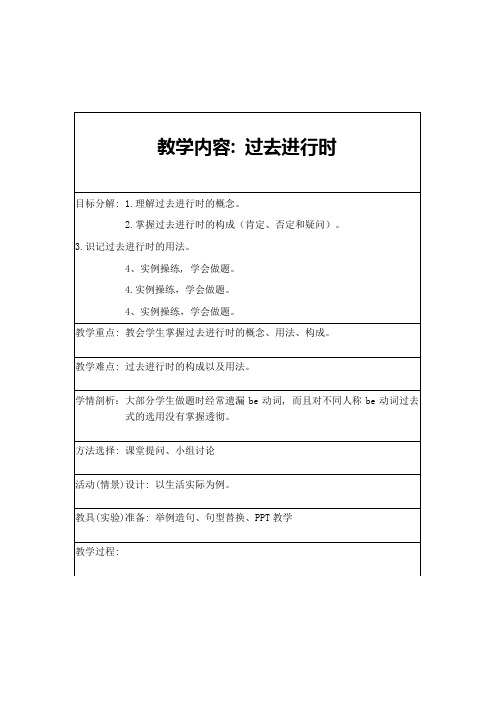
主句: 过去进行时;
从句: 一般过去时。
从句动作先于主句动作,
主句: 一般过去时;
从句: 过去进行时。
3)主从句动作无先后关系,
同时使用过去进行时, 从句一般由while引导。
四、习题演练
1.真题
(1).(2014湖南) Little Tom ______ computer games when his mother got home.
目标分解: 1.理解过去进行时的概念。
2.掌握过去进行时的构成(肯定、否定和疑问)。
3.识记过去进行时的用法。
4、实例操练, 学会做题。
4.实例操练,学会做题。
4、实例操练,学会做题。
教学重点: 教会学生掌握过去进行时的概念、用法、构成。
教学难点: 过去进行时的构成以及用法。
学情剖析:大部分学生做题时经常遗漏be动词, 而且对不同人称be动词过去式的选用没有掌握透彻。
1.过去进行时的构成(肯定, 否定和疑问)
2.过去进行时的用法
六、课后作业
按要求进行句型转换。
(1). We were having a PE class at4:00yesterday afternoon.(改为否定句)
We __________________ a PE class at four yesterday afternoon.
T:So what kind of tense these sentences belong to
乐东思源高中教学案(试行)
高 一 年级 英 语 学科 第 周 第二课时 主备人: 胡倩倩
2.过去进行时的构成
同学们, 那么过去进行时的构成是怎样的呢
过去进行时教案
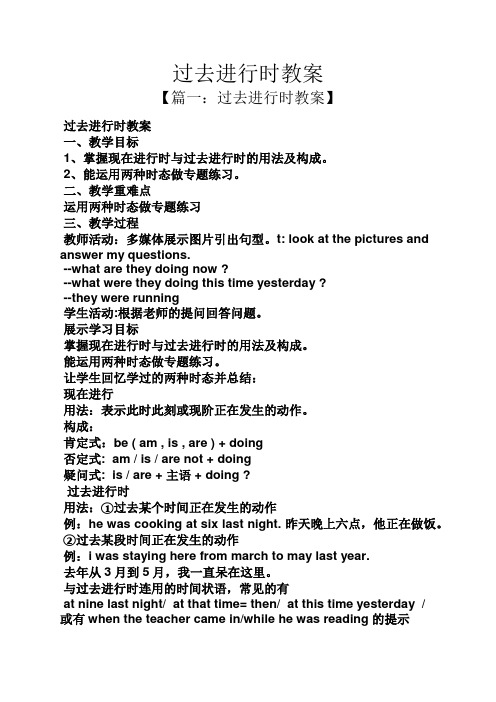
过去进行时教案【篇一:过去进行时教案】过去进行时教案一、教学目标1、掌握现在进行时与过去进行时的用法及构成。
2、能运用两种时态做专题练习。
二、教学重难点运用两种时态做专题练习三、教学过程教师活动:多媒体展示图片引出句型。
t: look at the pictures and answer my questions.--what are they doing now ?--what were they doing this time yesterday ?--they were running学生活动:根据老师的提问回答问题。
展示学习目标掌握现在进行时与过去进行时的用法及构成。
能运用两种时态做专题练习。
让学生回忆学过的两种时态并总结:现在进行用法:表示此时此刻或现阶正在发生的动作。
构成:肯定式:be ( am , is , are ) + doing否定式: am / is / are not + doing疑问式: is / are + 主语 + doing ?过去进行时用法:①过去某个时间正在发生的动作例:he was cooking at six last night. 昨天晚上六点,他正在做饭。
②过去某段时间正在发生的动作例:i was staying here from march to may last year.去年从3月到5月,我一直呆在这里。
与过去进行时连用的时间状语,常见的有at nine last night/ at that time= then/ at this time yesterday /或有when the teacher came in/while he was reading的提示构成:肯定式:be ( was , were) + doing否定式: was \were not + doing疑问式:was\ were + 主语 + doing ?现在分词的构成:1、一般情况下在动词末尾直接加ing;2、以不发音的字母e结尾的动词,先去掉e,再加ing;3、以重读闭音结尾的动词,如果末尾只有一个辅音字母,先双写末尾的辅音字母,再加ing;4、少数几个以ie 结尾的词,把ie 改为y,再加ing;用所给动词的适当形式填空1. now jim’s sister _____________(read) newspapers.2. he _______________(watch)tv at nine last night.3. he _______________(watch)tv last night.4. what ___________the twins __________(do) then?5. _____lily _______(draw) a cat when the teacher came in ? ------no, she _______6. _______you ___________(have) supper at that time?7. jack _____________(not read) a book at nine yesterday evening.8. now jim _____________(play) basketball on the playground (操场).9. what ________ he ___________ (do) at nine o’clock last night.10. they ______________ (listen) to the music at that time.11. when the teacher came in, the students ___________ (read) the text.12. we __________ (watch) tv when suddenly the telephone rang.【篇二:过去进行时教案】武汉龙文教育学科辅导教案附:跟踪回访表龙文教育教务处主任签字:【篇三:过去进行时教学设计】过去进行时教学设计。
初中英语_Unit 5 过去进行时教学设计学情分析教材分析课后反思
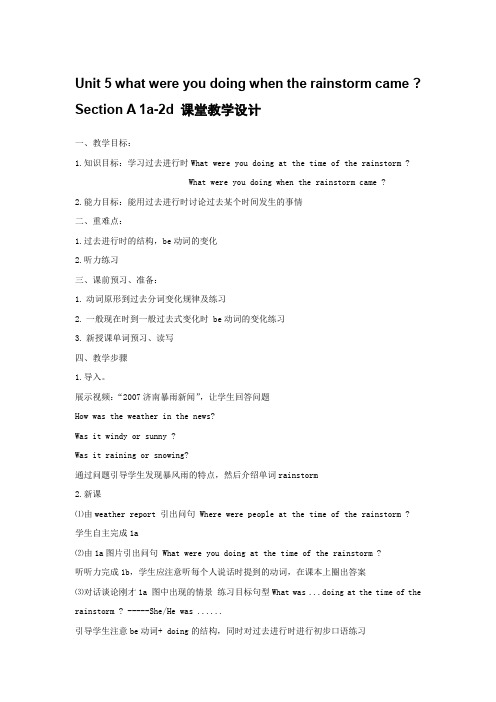
Unit 5 what were you doing when the rainstorm came ? Section A 1a-2d 课堂教学设计一、教学目标:1.知识目标:学习过去进行时What were you doing at the time of the rainstorm ?What were you doing when the rainstorm came ?2.能力目标:能用过去进行时讨论过去某个时间发生的事情二、重难点:1.过去进行时的结构,be动词的变化2.听力练习三、课前预习、准备:1.动词原形到过去分词变化规律及练习2.一般现在时到一般过去式变化时 be动词的变化练习3.新授课单词预习、读写四、教学步骤1.导入。
展示视频:“2007济南暴雨新闻”,让学生回答问题How was the weather in the news?Was it windy or sunny ?Was it raining or snowing?通过问题引导学生发现暴风雨的特点,然后介绍单词rainstorm2.新课⑴由weather report 引出问句 Where were people at the time of the rainstorm ?学生自主完成1a⑵由1a图片引出问句 What were you doing at the time of the rainstorm ?听听力完成1b,学生应注意听每个人说话时提到的动词,在课本上圈出答案⑶对话谈论刚才1a 图中出现的情景练习目标句型What was ...doing at the time of the rainstorm ? -----She/He was ......引导学生注意be动词+ doing的结构,同时对过去进行时进行初步口语练习给学生时间准备,然后找4组同学对四幅图分别进行对话练习⑷听力练习2a ,2b 找学生说出听到的答案⑸2c 引导学生注意句型 When the rainstorm suddenly came, what were you doing ? 通过变化句子顺序得到 What were you doing when the rainstorm came ? 对比前面学习的句子What were you doing at the time of the rainstorm? 注意句子结构。
过去进行时教案
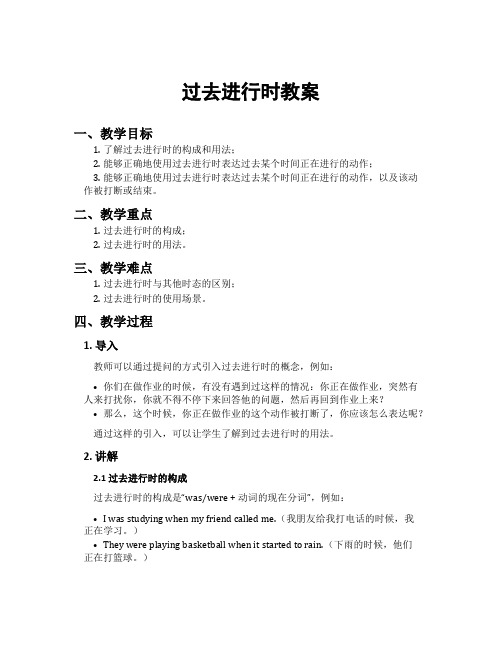
过去进行时教案一、教学目标1.了解过去进行时的构成和用法;2.能够正确地使用过去进行时表达过去某个时间正在进行的动作;3.能够正确地使用过去进行时表达过去某个时间正在进行的动作,以及该动作被打断或结束。
二、教学重点1.过去进行时的构成;2.过去进行时的用法。
三、教学难点1.过去进行时与其他时态的区别;2.过去进行时的使用场景。
四、教学过程1. 导入教师可以通过提问的方式引入过去进行时的概念,例如:•你们在做作业的时候,有没有遇到过这样的情况:你正在做作业,突然有人来打扰你,你就不得不停下来回答他的问题,然后再回到作业上来?•那么,这个时候,你正在做作业的这个动作被打断了,你应该怎么表达呢?通过这样的引入,可以让学生了解到过去进行时的用法。
2. 讲解2.1 过去进行时的构成过去进行时的构成是“was/were + 动词的现在分词”,例如:•I was studying when my friend called me.(我朋友给我打电话的时候,我正在学习。
)•They were playing basketball when it started to rain.(下雨的时候,他们正在打篮球。
)2.2 过去进行时的用法过去进行时用来表达过去某个时间正在进行的动作,例如:•I was watching TV at 8 o’clock last night.(昨晚8点的时候,我正在看电视。
)•She was cooking dinner when I arrived home.(我回家的时候,她正在做晚饭。
)过去进行时还可以用来表达过去某个时间正在进行的动作,以及该动作被打断或结束,例如:•I was studying when my friend called me.(我朋友给我打电话的时候,我正在学习。
)•They were playing basketball when it started to rain.(下雨的时候,他们正在打篮球。
过去进行时教案设计
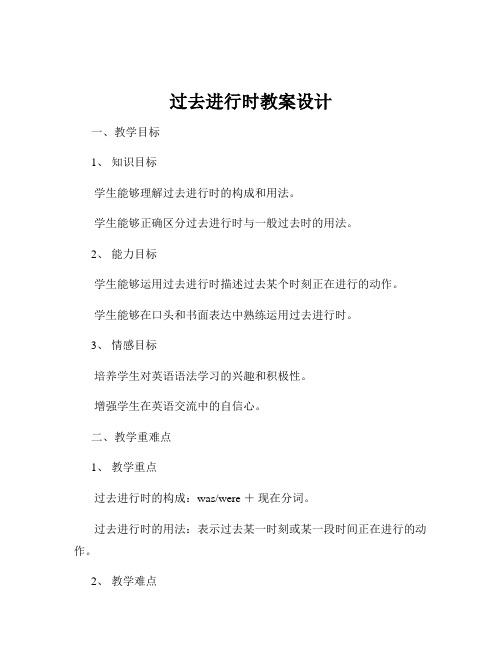
过去进行时教案设计一、教学目标1、知识目标学生能够理解过去进行时的构成和用法。
学生能够正确区分过去进行时与一般过去时的用法。
2、能力目标学生能够运用过去进行时描述过去某个时刻正在进行的动作。
学生能够在口头和书面表达中熟练运用过去进行时。
3、情感目标培养学生对英语语法学习的兴趣和积极性。
增强学生在英语交流中的自信心。
二、教学重难点1、教学重点过去进行时的构成:was/were +现在分词。
过去进行时的用法:表示过去某一时刻或某一段时间正在进行的动作。
2、教学难点过去进行时与一般过去时的区别和联系。
在实际语境中准确运用过去进行时。
三、教学方法1、讲授法通过讲解和示例,让学生理解过去进行时的概念和用法。
2、练习法安排各种形式的练习,如填空、造句、对话等,让学生巩固所学知识。
3、情景教学法创设生动的情景,让学生在实际情境中感受和运用过去进行时。
四、教学过程(一)导入(5 分钟)通过展示一些图片或播放一段视频,引导学生观察并描述图片或视频中的动作。
例如,展示一张一个人正在跑步的图片,问学生:“What was he doing?” 引导学生回答:“He was running” 从而引出过去进行时的话题。
(二)知识讲解(15 分钟)1、讲解过去进行时的构成:was/were +现在分词。
强调 be 动词的选择要根据主语的人称和单复数来确定。
例如:I was reading a book at that time (第一人称单数用 was) They were playing football (第三人称复数用 were)2、讲解过去进行时的用法:表示过去某一时刻正在进行的动作。
如:I was having lunch at 12 o'clock yesterday表示过去某一段时间内正在进行的动作。
如:He was studying English from 8 to 10 last night(三)对比一般过去时和过去进行时(10 分钟)1、举例说明一般过去时和过去进行时的不同:一般过去时表示过去发生的动作,强调动作的完成。
大学英语过去进行时教案

课程目标:1. 理解过去进行时的概念和用法。
2. 能够正确运用过去进行时描述过去某一时刻或一段时间内正在进行的动作。
3. 能够识别和翻译含有过去进行时的句子。
课程内容:1. 过去进行时的概念和构成。
2. 过去进行时的用法和例句。
3. 过去进行时与其他时态的区分。
4. 过去进行时在句子中的运用。
教学步骤:一、导入1. 引导学生回顾已学的英语时态,如一般现在时、一般过去时等。
2. 提问:你们认为还有什么时态可以帮助我们描述过去某个时刻或一段时间内正在进行的动作呢?二、讲解过去进行时1. 过去进行时的概念:过去进行时表示过去某一时刻或一段时间内正在进行的动作。
2. 过去进行时的构成:主语 + was/were + 动词的现在分词形式。
3. 过去进行时的用法:- 表示过去某一时刻正在进行的动作,例如:What were you doing at 7o'clock yesterday?- 表示过去一段时间内持续进行的动作,例如:They were watching TV the whole morning.- 表示过去某一动作延续时间较长,例如:She was reading the book all night.三、例句分析1. 展示含有过去进行时的例句,让学生分析句子结构和含义。
2. 学生分组讨论,找出句子中的过去进行时部分,并解释其用法。
四、练习1. 完成以下练习,巩固过去进行时的用法:- 将下列句子改为过去进行时:a. They are playing football.b. She is reading a book.- 根据句意,用过去进行时填空:a. At 8 o'clock last night, I _______ (watch) TV.b. While we were having dinner, _______ (the phone) rang.2. 学生互相练习,互相纠正错误。
初中英语课教案过去进行时含反思

初中英语课教案过去进行时含反思一、教学目标1. 让学生掌握过去进行时的概念和用法。
2. 培养学生运用过去进行时进行交流的能力。
3. 提高学生对英语时态的认知水平。
二、教学内容1. 过去进行时的定义和结构。
2. 过去进行时的用法和注意事项。
3. 练习题和小组活动。
三、教学重点1. 过去进行时的结构:was/were doing。
2. 过去进行时的用法:描述过去某个时刻正在进行的动作或状态。
四、教学难点1. 过去进行时与一般过去时的区别。
2. 正确运用过去进行时描述过去的事情。
五、教学方法1. 任务型教学法:通过完成各种任务,让学生在实践中学习和运用过去进行时。
2. 合作学习法:通过小组讨论和活动,培养学生相互协作、共同解决问题的能力。
3. 反思教学法:引导学生对自己的学习过程进行反思,提高学习效果。
1. 导入:通过提问引导学生思考过去发生的事情,引出过去进行时的概念。
2. 讲解:用PPT或黑板展示过去进行时的结构和使用场景,讲解过去进行时的用法和注意事项。
3. 练习:设计一些练习题,让学生用过去进行时描述过去的事情,及时给予反馈和纠正。
4. 小组活动:学生分组讨论,用过去进行时编写小故事,相互交流并展示。
5. 总结:让学生反思自己在学习过去进行时的过程中遇到的困难和问题,总结学习经验和方法。
6. 作业:布置一些有关过去进行时的家庭作业,让学生巩固所学知识。
7. 课后反思:教师对本次教学进行反思,总结优点和不足,为下次教学做好准备。
六、教学评估1. 课堂练习:通过即时提问和练习题,评估学生对过去进行时的理解和运用。
2. 小组活动:观察学生在小组活动中的表现,评估他们的交流能力和合作精神。
3. 家庭作业:批改学生提交的过去进行时相关作业,评估他们的掌握程度。
七、教学拓展1. 对比现在进行时和过去进行时的异同,让学生理解时态的相对性。
2. 引导学生运用过去进行时进行创意写作,如编写过去的故事或日记。
3. 推荐相关的英语学习资源,如在线课程、绘本或动画,以提高学生的学习兴趣。
过去进行时说课稿范文
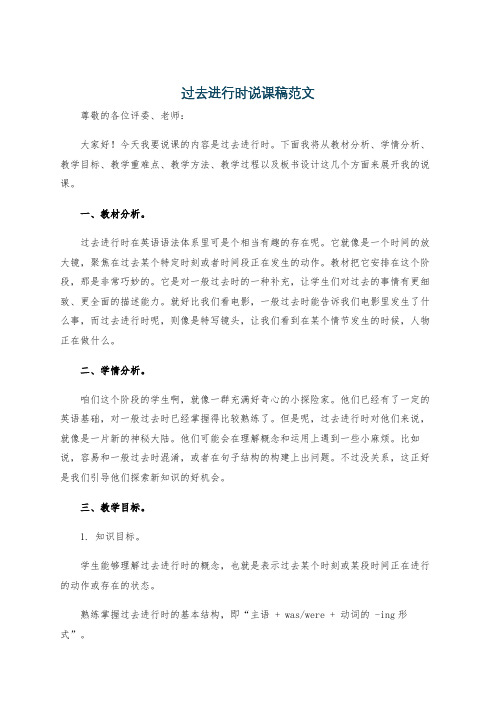
过去进行时说课稿范文尊敬的各位评委、老师:大家好!今天我要说课的内容是过去进行时。
下面我将从教材分析、学情分析、教学目标、教学重难点、教学方法、教学过程以及板书设计这几个方面来展开我的说课。
一、教材分析。
过去进行时在英语语法体系里可是个相当有趣的存在呢。
它就像是一个时间的放大镜,聚焦在过去某个特定时刻或者时间段正在发生的动作。
教材把它安排在这个阶段,那是非常巧妙的。
它是对一般过去时的一种补充,让学生们对过去的事情有更细致、更全面的描述能力。
就好比我们看电影,一般过去时能告诉我们电影里发生了什么事,而过去进行时呢,则像是特写镜头,让我们看到在某个情节发生的时候,人物正在做什么。
二、学情分析。
咱们这个阶段的学生啊,就像一群充满好奇心的小探险家。
他们已经有了一定的英语基础,对一般过去时已经掌握得比较熟练了。
但是呢,过去进行时对他们来说,就像是一片新的神秘大陆。
他们可能会在理解概念和运用上遇到一些小麻烦。
比如说,容易和一般过去时混淆,或者在句子结构的构建上出问题。
不过没关系,这正好是我们引导他们探索新知识的好机会。
三、教学目标。
1. 知识目标。
学生能够理解过去进行时的概念,也就是表示过去某个时刻或某段时间正在进行的动作或存在的状态。
熟练掌握过去进行时的基本结构,即“主语 + was/were + 动词的 -ing形式”。
能够准确地运用过去进行时进行简单的描述,像描述过去某个场景里人物正在做的事情。
2. 能力目标。
通过各种练习和活动,提高学生的听说读写综合能力。
特别是口语表达能力,让他们能自如地用过去进行时讲述故事或者描述经历。
培养学生的观察能力和逻辑思维能力,让他们能够从语境中准确判断何时该用过去进行时。
3. 情感目标。
激发学生对英语语法学习的兴趣,让他们感受到英语语法就像一个充满乐趣的拼图游戏,每一块都很重要,而过去进行时就是其中一块有趣的拼图。
增强学生的跨文化交际意识,让他们知道在英语文化里,准确运用时态是很重要的一部分。
- 1、下载文档前请自行甄别文档内容的完整性,平台不提供额外的编辑、内容补充、找答案等附加服务。
- 2、"仅部分预览"的文档,不可在线预览部分如存在完整性等问题,可反馈申请退款(可完整预览的文档不适用该条件!)。
- 3、如文档侵犯您的权益,请联系客服反馈,我们会尽快为您处理(人工客服工作时间:9:00-18:30)。
[内容提要] 含6大部分:本单元教学目标、知识背景、重点难点分析、词汇讲解、时态等语法突破、语言点19个的讲解。
资料贯穿整个单元,方便教师备课、学生学习、复习。
一. 本单元教学内容:Hello , boys and girls . How's everything going ? In this unit , we will learn to talk about past events and to tell a story .(一)语言目标(Language goals)1. Talk about past events . 谈论过去发生的事件。
2. Tell a story . 讲述故事。
(二)语言结构(Structures)1. 过去进行时态:“was / were + doing”结构Questions and statements with past progressive .2. Adverbial clauses with when and while .以when、while引导的时间状语从句3. 复习一般过去时(Past tense)(三)目标语言(Target Language)1. What were you doing when the UFO arrived ? I was sitting in the barber's chair .当UFO到达的时候,你正在做什么?我正坐在理发店的椅子上。
2. The barber was cutting my hair when they arrived .3. While he was buying souvenirs , a girl called the police .4. The girl was shopping when the alien got out .5. While the girl was shopping , the alien got out .6. How about you ? I was doing my homework .7. You're kidding .(四)词汇(Vocabulary)1. 部分动词的过去式took off(起飞、脱下) arrived(到达) landed(着陆)got out(下车、下来) shouted(喊叫) climbed(爬)happened(发生) ran away(逃跑)2. 部分动词的-ing形式cutting cooking eating getting out goingmaking shouting sleeping standing studyingtaking talking climbing buying coming3. when、while 当……时候4. bathroom(浴室) barber's(理发店) barber shop 理发店 shower(淋浴) police officer(警官)5. another(另一个) jump down(跳下来) go up(向上去)in front of(在……前面)(五)重点、难点分析1. 过去进行时:表示在过去某一时间内正在进行的动作。
构成:was / were + 现在分词(其中was是am、is的过去式,were是are的过去式)eg. 1) I was doing my homework then . 那时,我正在做作业。
2) He was cooking in the kitchen at 12 o'clock yesterday .昨天12点,他正在厨房烧饭。
用法:1)过去进行时表现过去某一时刻正在进行的动作。
eg. She was writing a letter when I came in .我进来时,她正在写封信。
2)过去进行时还表示过去某阶段正在进行的动作。
eg. They were waiting for you yesterday .他们昨天一直在等你。
2. 现在分词的构成1)一般动词在词尾加-ing,读[iη],如go→going。
2)以不发音字母e结尾的动词,先去掉e,再加-ing。
come→coming make→making write→writing3)以重读闭音节结尾的动词,如果末尾以一个辅音字母结尾,应先双写这个字母,再加ing,x和w结尾的除外。
如get→getting swim→swimming show→showing4)以字母y结尾的单词,直接加ing。
如carrying、playing、studying。
5)以字母ie结尾的动词,变ie为y,再加ing。
die→dying lie→lying6)以元音字母加e结尾,或以e结尾,且e发音的动词,直接加-ing 。
see→seeing be→being3. 使用进行时态的注意事项1)一些动词,如see、hear、love、like、know、remember;understand、have等表示感情、知觉和状态的词,一般不用于进行时态。
2)在there和here引起的句子中,常用一般现在时代替现在进行时。
eg. Here comes the bus .There goes the bell .4. 过去进行时和一般过去时的区别1)过去进行时表示过去正在进行的动作,而一般过去时则表示一个完整的动作。
如:They were writing letters to their friends last night .昨晚他们在写信给他们的朋友。
(没有说明信是否写完)They wrote letters to their friends last night .他们昨晚写了信给他们的朋友。
(表达了他们已写好的意思,整个写的过程已完成。
)2)当动作延续较长时间时或表示厌烦、赞美等感情色彩时,常用过去进行时表示。
如:He was thinking more of others than of himself .他考虑别人的比考虑自己的多。
(表示说话者赞扬的口气)The boy was always making trouble then .那时,他总是惹麻烦。
(表示说话者厌烦的口气)5. 以when和while引导的时间状语从句1)延续性动词和非延续性动词延续性动词指动作可以延续一段时间,而不是瞬间结束。
如:work、study、drink、eat等。
非延续性动词指动作极为短暂,瞬间结束。
如:start、begin、hit、jump、knock等。
2)在本单元中,出现了以when和while引导的时间状语从句。
<1> when表示“当……的时候”。
从句中既可用延续性动词,又可用非延续性动词,这些动词既可以表示动作,又可表示状态。
从句中的动作既可和主句的动作同时发生,又可在主句的动作之前或之后发生。
如:Mary was having dinner when I saw her .The boy was still sleeping when his mother got home yesterday morning .<1> while表示“在……的时候”、“在……期间”。
它强调主句的动作与从句的动作同时发生或主句的动作发生在从句的动作过程中。
while从句中必须是表示动作或状态的延续性动词。
如:The weather was fine while we were in Beijing .She called while I was out .如果主句的动作在从句的动作过程中发生,从句常用进行时。
如。
While we were swimming someone stole our clothes .Don't talk so loud while others are working .总结:<1> when可指时间点,又可指时间段,从句中可用延续性动词,也可用非延续性动词。
<2> while总是指一个时间段,从句中必须用延续性动词。
6. In this unit , we'll learn how to tell a story . Let's take section B 3a as an example . 1)Listen to this story 听这个故事Linda Jacobs loves her dog Davy . They went to New York City last Saturday . While Linda was buying a newspaper at the train station , the dog got out of his box and ran away . The station was crowded and Linda couldn't see Davy anywhere . When Linda shouted his name , some people looked at her but Davy didn't come . Then she called the police . While she was talking on the telephone , Davy met another dog outside the station . While the police were coming , Linda walked around the station and called Davy's name . She didn't think about looking outside the station . Finally , a little boy said to he r , “Did you look outside ? I saw a big black dog when I came in .” When Linda finally saw Davy , he was jumping and running with another dog . There was a police officer next to them . The police officer said to Linda , “I think my dog found your dog .”注意事项:a. 交代清楚故事发生的时间、地点及人物。
